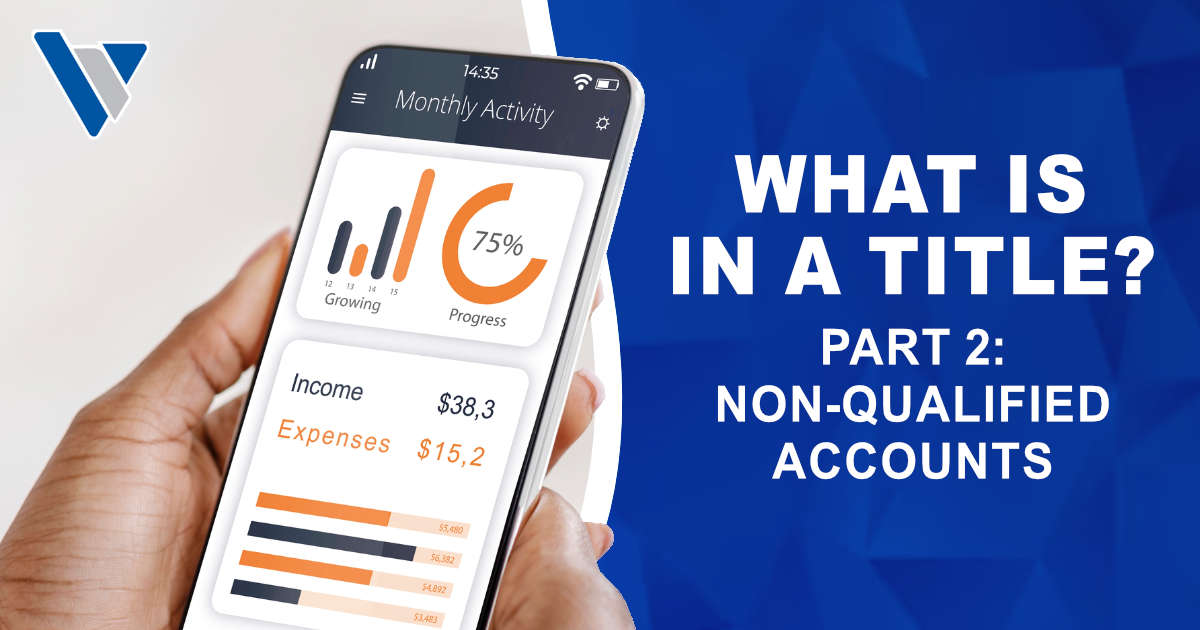In my last article, I discussed the importance of proper titles in regards to qualified accounts,...


I was at a nephew’s wedding a while back and a family member asked me to speak with their son, who was in his younger 20s, and give him some money advice. We sat down and spoke over a couple of drinks and had a great conversation. I thought I would share parts of this conversation so you might be able to share it with younger people you know.
We should recognize that the younger crowd, those still in their 20s, have it much harder than any other older generation in regards to building wealth, with the exception being those still alive who lived through parts of the depression. Unless there are major changes, it will be very difficult for those in their 20s or younger to have a better lifestyle than their parents when they get to the same age. Housing costs are too high for those just starting out. The impact of inflation over the past couple years means they are paying 20%-30% more for the same food, gas, etc. Wage inflation has not kept up with real inflation. The younger crowd is playing catch up and they might not get there for years.
It is what it is though and makes prudent management of money even more important for those generations. There also needs to be a reset on certain thoughts because what might have worked before may not work going forward.
I have read many quotes on the difference of how the rich versus poor view money. In my many years of experience, it is quite simple. The poor spend all their money and save none, the middle class spend their money and invest what is left, and the rich invest their money and spend what is left.
The big difference is how they view money. Is it to buy things, like the new Tesla (more on cars later) or a larger house than they truly need, or is it to invest and make it grow for you so they can build true financial freedom? People typically land on one side or the other. Start as early as possible by creating an investment plan that is a top priority, not prioritize a spending plan. Prioritizing a spending plan is focusing on buying nonessentials first with your money versus buying appreciating assets.
Start off by contributing to a Roth or 401k. That should be priority number 1 even if it means you can’t buy a new car. For many young earners, a Roth IRA might be the best option long-term. Unless a company matches in a 401k and does not have a Roth option, take the free money and contribute to the 401k. Here is a major tip for you though. Start off with what you can afford to contribute at that time, whether it be 3%, 10% or 15%. However, if you start off low, each time you get a raise, increase the percentage by at least one. You will be surprised by how much you don’t miss that money. If your company doesn’t have a 401k, contribute to an IRA.
Excluding the essentials, buy assets, not liabilities. The two absolutely worst liabilities, from my perspective, that are typically bought by those yet without financial freedom and that keep them from having financial freedom or delays it materially, are cars and pools. The first rule of cars is to pay cash if you can. Second rule, if you have to get a 5, 6, or longer-term loan, you can’t afford the car. Don’t buy it. I understand when you’re first starting out, paying cash can be an unreasonable expectation. It isn’t unreasonable to buy within your means, which is a 3- or 4-year note, not a 5 or 6-year one. It also doesn’t matter that CD rates are higher or you think you can make more. The entire notion of doing one thing and investing the difference is fool’s gold. People rarely invest the difference. They spend the difference.
When you are thinking about how much you can afford in monthly payments, thus extending out to 5- or 6-year loans to achieve that lower monthly payment, just remember you are consciously agreeing to a financial deal in which you pay a company interest for an “asset” that is guaranteed to become almost worthless in 10 or so years. When Willy Sutton was asked why he robbed banks, he responded “Because that is where the money is.” Getting people to pay them a lot of interest for a depreciating asset is one of the reasons banks are where all the money is.
I would much rather you be house-poor versus car-poor. A house has equity that is expected to increase. Embrace higher mortgage rates. If history repeats, longer-term it will benefit you, especially if you are younger. The important thing to consider when buying real estate is prices typically increase when interest rates are decreasing. It is simple supply and demand: more people can afford homes, or larger homes, if interest rates are lower. It might stretch your budget, which means eating out less, driving an older car, or fewer vacations now but long-term it may mean more vacations, new cars, and eating out more. Short-term pain for long-term gain. If you must have a pool, buy one instead of building one. On pools, before building one, know what you are buying. Can you pay cash? If not, once again you are paying interest on a depreciating asset. One estimate I saw is you can expect to retain only 10-20% of the pool cost when you sell.
Owning rental property can be very beneficial long-term but it typically takes over 3-4 properties to make it truly financially rewarding. However, that is very achievable if you use leverage in a smart and effective manner. Owning only one or two properties can be a nightmare. One bad tenant can drain you both personally and financially. The excellent wealth-building aspect of real estate is the ability to use leverage in a way that can be less risky than leverage in equities due to the higher volatility in stocks.
The stock market is meant to build wealth, not riches (excluding company stock options). Understanding the rule of 72 will help you manage your expectations and risk. The rule of 72 is simply divide 72 by either the number of years you want your money to double to determine the return needed or divide 72 by the expected return and it will give you the years it will take.
I have had people tell me they expect or want their money to double in 2 to 3 years. Let’s use 3, that means you need an average return of 24% for 3 years for it to double, which is an unrealistic expectation. Even using five years means an expected return of over 14% annualized, which is a lofty expectation. Often, chasing these unrealistic returns creates more harm than good. A younger person should almost always take more risk with money they don’t need short term. There is, however, smart risk versus, let’s say, not-so-smart risk. I get it, we hear people who made millions in cryptocurrency or a single stock. We also hear about people who win the lotto. How much money is wasted on lotto tickets by people who never win? We also rarely hear about the person who lost all their money investing in one high-risk investment. Buying a very risky asset when young is fine as long as one remembers to diversify and they don’t forget that if you lose 50% on an investment, it takes a 100% return just to get back to even. If you start placing real value in the long-term benefit of compounding returns you might be surprised to learn you can add significant long-term wealth when using the market for what it was intended for without taking that not-so-smart risk.
You are currently setting the foundation for your financial future and starting off on solid ground will benefit you later as you and your assets grow. Think of your financial advisor as a resource there to answer all of your financial questions and concerns. Knowledge and planning are your path to empowerment.
Content in this material is for general information only and not intended to provide specific advice or recommendations for any individual. Investing involves risk including loss of principal. No strategy assures success or protects against loss. There is no guarantee that a diversified portfolio will enhance overall returns or outperform a non-diversified portfolio. Diversification does not protect against market risk.